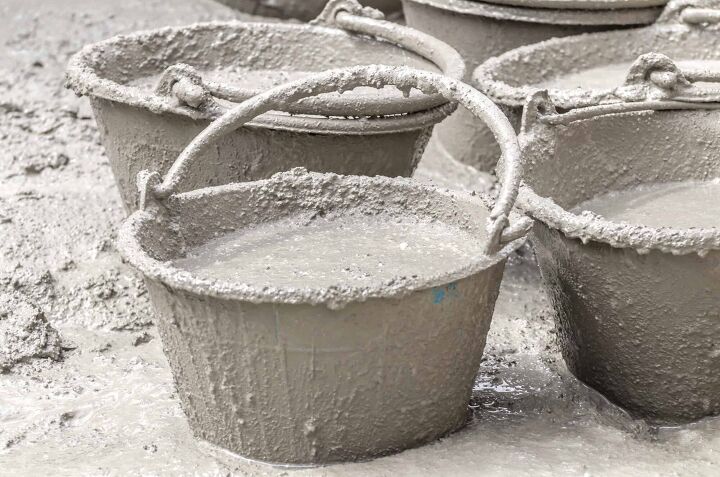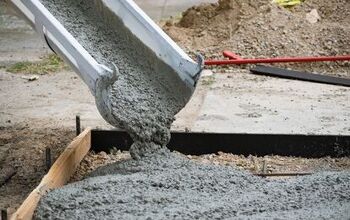How Much Does A Gallon Of Concrete Weigh? (Find Out Now!)

If you’ve ever watched a movie with construction crews, you might’ve noticed how big and burly the workers look while they’re carrying buckets of concrete. (Or, in my case, you might’ve just been a teenager who was gawping at guys.) Concrete is clearly a pretty thick substance. It’s heavier than it looks and if you’re doing a DIY concrete session, you probably should know how much a gallon of the stuff weighs…
When mixed, a gallon of concrete weighs in at about 20.08 pounds. However, the weight of this can change depending on how the concrete is mixed, as well as what ingredients are in it. This weight is not the same for cement, as cement and concrete are two different things.
Trying to figure out how much your concrete will weigh can come in handy from time to time. This guide will help you understand what you should be aware of when you’re putting together your project.
It’s important to note that not all concrete is the same; there are 25 Different Types Of Concrete.
Before We Begin: Why Do You Need To Know The Weight Of A Gallon Of Concrete?
Most of the time, this is a matter of logistics. There are a lot of projects that may require you to transport large amounts of concrete. If you’re transporting 10 gallons of concrete, that’s 200 pounds of stuff you need to haul. If you have to transport a barrel that’s been filled with concrete, that’s going to be over 1000 pounds. By that point, you will need to have mechanical assistance to make it move.
Sometimes, it’s also a matter of trying to make sure that the structure that you’re putting the buckets of concrete on will be able to hold the weight. Either way, it’s good to know.
How Do You Calculate The Weight Of A Gallon Of Concrete?
For the most part, people will be able to use the standard 20-pound weight described above for their calculations. Most of the time, the differences between concretes will be negligible. However, you can usually calculate it by using general rules of thumb. This is what you need to be aware of below:
- The vast majority of concrete mixes will be 150 pounds per cubic foot. A five-gallon barrel is about 2/3 of a cubic foot. That makes it 20 pounds per gallon, or 100 pounds for the entire barrel.
- Lighter concrete mixes can vary in weight between 90 to 110 pounds per cubic foot. This will lead to about 12 to 14 pounds per gallon. These mixes are often used in crafts where there needs to be a lighter weight for ease of carrying.
- Heavyweight aggregate concrete mixes will begin their weight range at around 300 pounds per cubic foot. This makes a typical gallon of heavyweight concrete start at 40 pounds per gallon once it’s mixed. It’s important to remember that this is just the beginning.
What Kind Of Concrete Weight Should You Get?
I wish I could wave a magic wand and tell you, but the truth is I can’t. It all depends on the project that you want to do. More often than not, choosing standard weight concrete is the best pick when you can’t find instructions on which concrete weight to buy. After all, it’s standard because it works with most projects. It’s rare to actually see lightweight concrete in use.
When Does Using Heavyweight Aggregate Concrete Make Sense?
Heavyweight aggregate concrete isn’t necessary for most projects, but it still has its uses. One thing that should make sense to people in the DIY sphere is that heavyweight concrete should generally be used when you need high-density materials for one reason or another. The most common issues that you may use for this include:
- Anchors. If you need to make a concrete anchor, heavyweight concrete is a good option. The heaviness of the anchor means that it will be more likely to give your boat (or anything else) a solid mass that will hopefully keep your craft in place. Ideally, you will use metal rather than concrete, but we can’t judge here.
- Bridge Counterweights. Without a doubt, one of the most common reasons for people to use aggregate concrete is in the creation of bridges. This concrete is typically used in bridge counterweights as well as the base of bridges that are underwater.
- Radiation Shields. We’ve all watched Chernobyl and have heard the stories about how radiation can be blocked by concrete. Thicker density concrete tends to be the best option for this.
What’s The Best Way To Move Concrete?
Ideally, you won’t have to move the concrete you’re using too far from where you mixed it. This is why you are usually advised to mix concrete right next to the area that you want to apply the concrete to. After all, moving concrete isn’t always easy to do. Even if you have a wheelbarrow filled with concrete, it’s going to be tough to physically move 800 pounds on your own.
If you need to move lots of concrete, it’s good to choose one of these methods below:
- A Portable Concrete Mixer. This is the easiest way to make sure that you get the most out of your concrete transportation. The mixer will help you make sure that your concrete doesn’t start to settle and dry.
- A Bucket. If you just need to have a small amount of concrete for a quick project or patching job, then a bucket works well. Just make sure to stir it once in a while.
- A Wheelbarrow. When moving the concrete, make sure to wheel the wheelbarrow to the area before you add the water to the concrete and stir it up.
Is Cement The Same Thing As Concrete?
No, they aren’t. Most people tend to use the two interchangeably, but they are different terms for fairly different things. Cement is a dry powder that’s actually a primary ingredient of concrete. Cement is a part of the “paste” that concrete aggregate is mixed with. On average, concrete will be 10 to 15 percent raw cement.
Believe it or not, cement can’t actually be poured on its own. It always has to be mixed in order to remain sturdy enough to handle basic supports. So, there’s no such thing as a cement sidewalk, cement stepping stones, or cement masonry. This is all concrete in one form or another.
Related Questions
What is concrete made from?
Concrete is made from a number of different items, all depending on the specific mix you have. The most important ingredients in modern concrete include cement, water, and aggregate. When people talk about aggregates, they tend to mean small stones that help strengthen and fill out the concrete.Aggregates can include anything from sand, to gravel, to more dense matters like ground up hematite. In some cases, people have started to use ground-up glass as a way to help upcycle material that would otherwise be tossed out.
Will concrete harden underwater?
Believe it or not, it will. Concrete has a natural ability to harden as soon as it interacts with water. So, if you place concrete underwater, it will continue to harden. This is one of the many reasons why new concrete isn’t as hard as old concrete. It’s worth noting that this only tends to be true when talking about concretes made with Portland cement.With that said, Portland cement is the most common type of cement currently being used today. So, it’s usually a safe assumption that concrete will harden underwater.
How much strength is required of high-strength concrete?
High-strength concrete can carry out compressive strengths between 7,000 to 14,000 pounds per square inch. Conventional concrete is still quite strong. It can carry a compressive strength of up to 7,000 psi. Due to the fact that concrete is naturally strong as a material, it’s extremely rare that you will find a need to use high-strength concrete in a typical DIY home project.

Ossiana Tepfenhart is an expert writer, focusing on interior design and general home tips. Writing is her life, and it's what she does best. Her interests include art and real estate investments.
More by Ossiana Tepfenhart



























